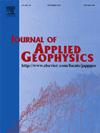An improved stochastic inversion of P- to S-wave velocity ratio and compressional modulus based on fast Fourier transform moving average co-simulation
IF 2.2
3区 地球科学
Q2 GEOSCIENCES, MULTIDISCIPLINARY
引用次数: 0
Abstract
The stochastic seismic amplitude-versus-angle (AVA) inversion is extensively utilized in the estimation of elastic properties and rock physics parameters from seismic data. This method can substantially improve the resolution of reservoir identification in areas where well data are available. Compared with conventional sequential simulation methods, the fast Fourier transform moving average (FFT-MA) simulation exhibits a superior computational efficiency. However, given the limitations of FFT-MA simulation in the simultaneous simulation of multiple elastic properties (such as compressional modulus, VP/VS, and density), the effective application of this method in seismic AVA inversion is challenging. In this study, we propose an FFT-MA co-simulation method for the simultaneous simulation of multiple elastic parameters. This approach establishes possible models constrained by the joint probability distributions of inverted properties, which enhances the accuracy of co-simulated results. Furthermore, we introduce an iterative update method designed to enhance convergence during inversion processes and increase the inversion accuracy. Consequently, an efficient stochastic inversion method is developed through the combination of the FFT-MA Co-simulation method with the iterative update method. The effectiveness of the proposed inversion method is validated through numerical examples and field data application.
基于快速傅里叶变换移动平均联合模拟的纵波速度比和纵波模量的改进随机反演
随机地震振幅与角度(AVA)反演被广泛应用于从地震资料中估计弹性性质和岩石物理参数。在有井资料的地区,这种方法可以大大提高储层识别的分辨率。与传统的序列仿真方法相比,快速傅里叶变换移动平均(FFT-MA)仿真具有更高的计算效率。然而,考虑到FFT-MA模拟在同时模拟多种弹性特性(如压缩模量、VP/VS和密度)方面的局限性,将该方法有效应用于地震AVA反演是一个挑战。在这项研究中,我们提出了一种FFT-MA联合仿真方法,用于同时模拟多个弹性参数。该方法建立了受倒性质联合概率分布约束的可能模型,提高了联合模拟结果的准确性。此外,我们还引入了一种迭代更新方法,旨在增强反演过程中的收敛性,提高反演精度。因此,将FFT-MA联合仿真方法与迭代更新方法相结合,开发了一种高效的随机反演方法。通过数值算例和现场数据应用验证了所提反演方法的有效性。
本文章由计算机程序翻译,如有差异,请以英文原文为准。
求助全文
约1分钟内获得全文
求助全文
来源期刊

Journal of Applied Geophysics
地学-地球科学综合
CiteScore
3.60
自引率
10.00%
发文量
274
审稿时长
4 months
期刊介绍:
The Journal of Applied Geophysics with its key objective of responding to pertinent and timely needs, places particular emphasis on methodological developments and innovative applications of geophysical techniques for addressing environmental, engineering, and hydrological problems. Related topical research in exploration geophysics and in soil and rock physics is also covered by the Journal of Applied Geophysics.
 求助内容:
求助内容: 应助结果提醒方式:
应助结果提醒方式:


